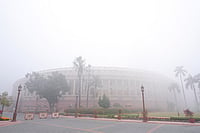And we are told that these deals between the Schmidts and Smiths of Europe are an immensely promising way to stop Himalayan glaciers from melting, to make sure that floods don't come to Bangladesh and refuse to recede, that the Pacific island nation Tuvalu (pop. 11,636) does not capsize, president and all. We are told this not by some environmental freak in a seminar room but by the most-talked-about global agreement between almost all governments, the Kyoto Protocol.
An unusual kind of protocol that they all signed in Kyoto in Japan in December 1997. It was agreed that the burning of fossil fuels like coal, gas and oil in factories, power plants and cars lead to huge emission of gases like carbon dioxide and methane that warm the atmosphere (and are therefore called greenhouse gases). Western countries acknowledged that they produce most of the emissions because they have the bulk of industry and transport, so they accepted they must do something about it first. So they agreed to cut emissions by at least 5.2 per cent by the end of the first implementation period of the Kyoto Protocol, 2008-2012, relative to 1990 levels.
But this was never going to be about western corporations taking responsibility for messing up the atmosphere, and then offering to fix it at their cost. So the best way to clean up the air would be to set up shop. The Kyoto Protocol would be implemented by "market mechanisms", among them the Emissions Trading Scheme. This market (which Schmidt and Smith went to) opened in the European Union January 1 this year. Others have set up stall to trade here and there.
A very proper market, with electronic exchange and all. Emissions on the 'carbon' market have been selling this week around 29 euros a tonne. And as with any stockmarket, prices are driven strongly by speculation. You can sell what you think someone may not produce for more than they think their lack of output is worth. You could buy what you believe someone may produce more than they should, and more than they think they might. The futures market pioneered in Chicago bought and sold anticipated produce; this one trades in estimates of a lack of produce. It would be unreal if it was not actual.
The EU market covers at present about 12,000 industrial units thought to generate about 46 per cent of EU greenhouse gases. The market excludes transport, the fastest growing pollutant, and household energy use. Already around a million allowances are traded every day. Corporations are expecting new worldwide investment of as much as $16 trillion in new energy sources worldwide. Clean technology for many of these generation plants (that are not hydro or nuclear) will be a towering market for the emissions trading market to lean on. So it's not all in the air.
And not necessarily trade among corporations in the developed world either. The Kyoto Protocol has two other 'market mechanisms' that tie into emissions trading. Under Joint Implementation (JI), a western corporation can get credits for clean technology investment in an East European country, under the Clean Development Mechanism (CDM) in a developing country. So if General Electric and the Maharashtra Power Development Corporation had not had their little disagreement, GE could have claimed introduction of clean technology at Dabhol that would save 'n' carbon tonnes of emissions from escaping into the atmosphere. Those could be transferred to its emissions quota in Europe (since the US is out of Kyoto). It could use those 'n' tonnes to emit that much more in Europe without paying. If its emissions were less than its quota, it could simply sell the excess on the carbon market to a speculator or someone emitting more than their quota.
Manmohan Singh and developing co. (China, South Africa, Mexico, Brazil in the G 9-13 calling itself the G5) argued at the G8 summit at Gleneagles, Scotland, that the CDM is there to make transfer of clean technology possible to developing countries. The developing countries are not bound under Kyoto to cut emissions, or in fact to do anything at all. So under the CDM, western industry can get credits by implementing clean technology cheaper, and developed country industry gets clean technology. But not necessarily with the right to use it elsewhere. The G5 want clean technology under Kyoto, the G8 are talking now of the need for developing countries to abandon their right to do nothing post-2012. Particularly India and China because of their rapidly growing energy and industrial market.
So easy to forget, isn't it, to ask how a Himalayan glacier slides into these market forces? The market wants us to accept the following link: the West produces most of the emissions; when one European company buys the other's capacity to pollute, the pollution is transferred but capped, and rising prices of carbon tonnes will eventually push industry to bring in clean technology; this will limit emissions and therefore unusual warming; this then will mean that Arctic icebergs, Himalayan glaciers and the like will no more melt as fast as they are now; nature will be beautiful again and sustain us all as it should. Leave it to Smith. Or Schmidt. The market can sort everything out, nature too.


























